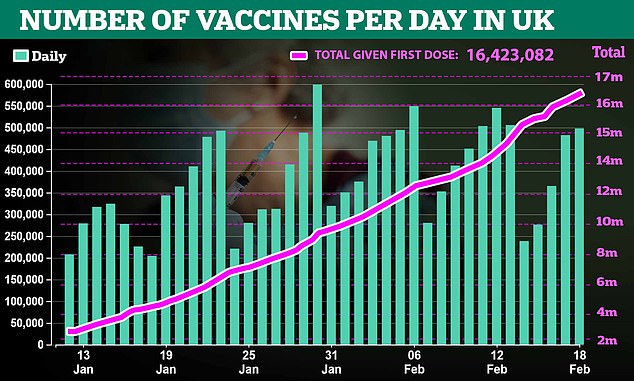NHS hospitals are now treating FEWER Covid patients than they were during darkest days of outbreak last Spring as statistics show hospitalisations have halved since January
- There were 20,156 Covid patients in hospital compared to 39,242 in January
- Those on ventilation beds plunged from 4,077 in January to 2,614 on Wednesday
- Data shows Covid cases plummeted to their lowest levels since September
NHS hospitals are now treating fewer coronavirus patients than they were during the darkest days of the first wave, official figures have revealed.
Department of Health data shows 20,156 beds were taken up by Covid-infected Brits on February 16, the most recent day figures are available for.
For comparison, there were more than 21,000 coronavirus patients needing hospital treatment on the worst days of the original outbreak last April.
The data also shows the number of Covid patients in hospital has nearly halved since January. Almost 40,000 beds were taken up by the infected during the peak of the second wave last month.
And the number of patients on ventilation beds has also plunged by 36 per cent in a month.
It comes as official data released yesterday showed cases have plummeted to their lowest levels since September — before the second wave spiralled out of control.
Department of Health bosses recorded 12,057 new infections, marking a 10.6 per cent drop from last Thursday. Another 454 deaths were also announced, a 33 per cent fall on last week.

Separate Public Health England figures revealed cases among school-age children have plunged to their lowest levels in five months. Around 86 cases were recorded per 100,000 10 to 19 year olds in the week ending February 14 — the lowest rate since September.
The encouraging fall in hospitalisations comes as the Prime Minister faces growing clamour for a speedier lifting of lockdown measures.
Boris Johnson is set to unveil his ‘roadmap’ back to normality on Monday, with his approach set to make pubs and restaurants among the last places to reopen.
But there are indications the fall in cases is beginning to slow, with scientists urging the public to continue to obey lockdown rules.


Saffron Cordery, deputy chief executive of NHS Providers, told The Times that the country was at a ‘critical juncture’, with hospital staff ‘exhausted.
She urged Boris Johnson to wait for ‘a return to more normal levels of NHS capacity’ before lifting restrictions.
She said: ‘Lessons must be learnt from the past year if this is to be the last national lockdown.’
Some 2,614 patients requiring intensive care on mechanical ventilation beds on Wednesday, compared to 4,077 on January 25.
Public Health England’s data yesterday showed the infection rate among children aged 10 to 19 was at 86.2 per 100,000 in the second week of February, the latest available.

This is below every week since the seven-day spell ending September 26, when it was 53.4 per 100,000.
Public Health England’s medical director Yvonne Doyle said: ‘Our efforts are working as case rates, hospitalisation rates and deaths are slowly falling.
‘The number of new infections is higher than the end of September and remains concerning.
‘This could increase very quickly if we do not follow the current measures. Although it is difficult, we must continue to stay home and protect lives.’
Covid cases also dropped in every age group and plunged by 38 per cent among the over-80s – who are most at risk of being hospitalised or dying if they catch the virus – to 129.6 per 100,000.
The infection rate was highest in 30 to 39-year-olds (192.5 per 100,000), followed by 20 to 29-year-olds (173.4 per 100,000) and 40 to 49-year-olds (162.9 per 100,000).
